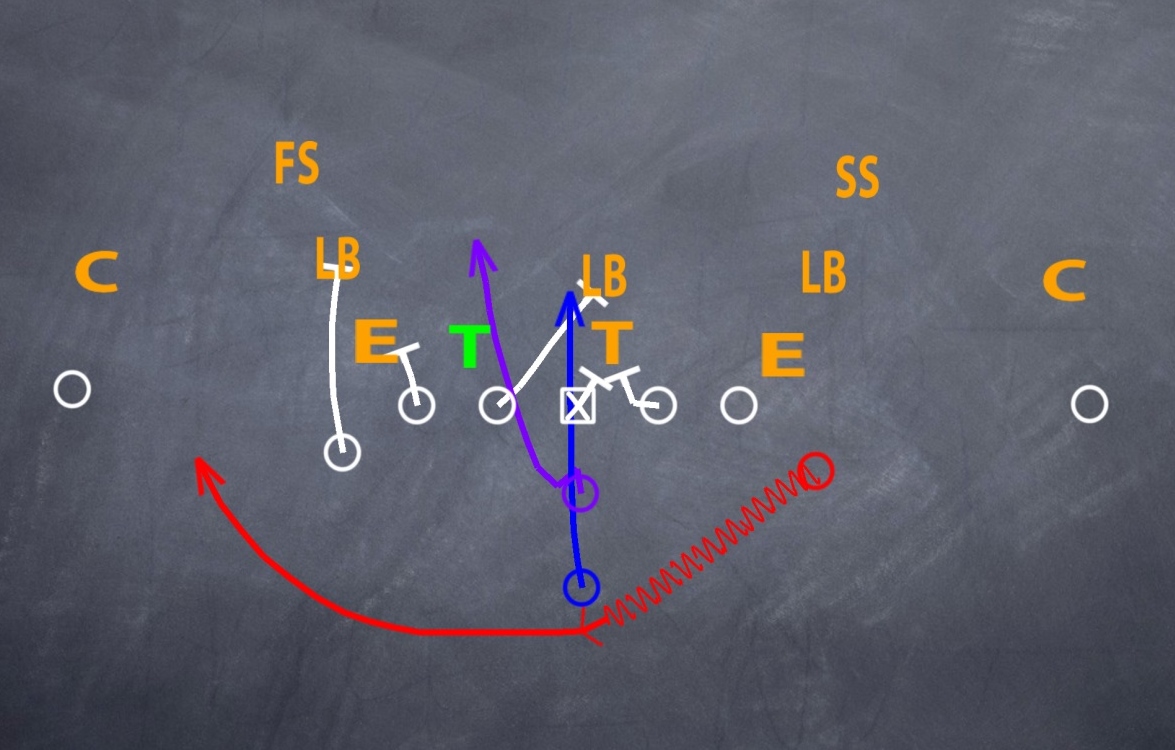
I love using the 4-3 defense’s over front because it is one of the most versatile defensive fronts in the game. There are times, however, when we know that the offense wants to run the ball. In those situations, we like to use the under front.
The under front creates one less bubble on the offensive line. Your linebackers can concentrate on one gap, rather than the 2-gap over front backer play. But your defensive line will not require any new teaching, and all of the stunts, blitzes and coverages you run with the over front translate easily to your 4-3 over defensive front.
Aligning in the Under Front
Your defensive line will not need to learn any new skills to run the 5-man under front. The under, which is sometimes referred to as a shaded 5-2 defense, lets your defensive line play in the same outside shade technique they used before (Figure 1).
To make the teaching easy, let’s back up to day one. While we will probably never line up in it, the first front we learn is called “Heads.” We start with the strong end head up on the tight end, and the tackle and nose head up on their guards (Figure 2).

When we teach the over front, we teach them to slide over toward the strength call (the direction of the Tight End). That gives us our 9- technique defensive end, 3-technique tackle, 1-technique nose, and our 5-technique weakside end. We never move the weakside defensive end from his 5- technique (Figure 3).

After a few days of running the Over front, we install the under front. Put the defensive linemen back in “Heads.” If they slide over to the call on over, it makes sense that on under front, they slide away from the strength. Now we have our 5-technique strong end, 1-technique tackle, 3- technique nose, and our 5-technique weak end (who has not moved!).
What about the linebackers? They learn the same way – only opposite of the defensive line. In the “Heads” front, the linebackers are stacked directly behind the strong end and tackle, and over top of the weakside offensive tackle (Sam, Mike and Will, respectively). (Figure 4)

When we go to the over front, the backers slide away from the strength call. That moves the Sam to his 50-technique, thr outside shade of the tackle. The Mike moves to a weak-10, and the Will moves to a weak-50. On the under front, the Will goes to a weak-30 technique and the Mike slides to the strength, in a strong 30-technique. The big difference comes for the Sam Linebacker, who walks up on the line of scrimmage (LOS) in a 9-technique, the outside shade of the tight end.
Now that we have taught the alignment of the front, everything else is easy. Or is it?
Coaching the Under Front
So why would anyone not run the under front? It will require some extra work by your linebackers coach, or defensive line coach, to get your Sam Linebacker ready to play his stand-up defensive end position in the under front. Your Sam Linebacker now becomes a spill player on the defensive line. On down blocks by the tight end, he comes hard down the LOS and looks to spill any pulls or kick outs. With our quarters coverage, he has the strong safety behind him to box outside run plays.
It does not come naturally to many linebackers to play the block-down, step-down rules that our defensive linemen are so used to. If you are in a heavy run situation, your team may prefer to use a third defensive end at the 9-technique position.
We like to be able to move in and out from our over front to the under front. That requires some extra teaching for the 9-technique defensive end. While you may not need the under front in your first few weeks of the season (and we often don’t with the high number of spread offenses), it is worth installing and repping heavily during camp. You do not have to use the Sam Linebacker, either. In some years we have used our Will Linebacker or even the Mike Linebacker, because they were more capable of coming down on the LOS and playing a defensive line position.
Another consideration for keeping your linebacker in at the 9-technique position is the passing game. We do not change our quarters coverage responsibilities for the Sam Linebacker, despite the fact that he is aligned on the LOS.
Adjusting to Formations
The under front can easily be adapted to a wide variety of formations. The under front is perfectly capable of being your base defensive front, if your players are more comfortable in it than they are in the over front.
If we see a 2-tight end alignment, the Will Linebacker makes a “Heavy” check that slides the weak end out to a 7-technique, the inside shade of the second tight end. No further adjustments are necessary (Figure 5).

Against a formation with no tight ends, the Sam Linebacker does not walk down on the line. He will play at his normal linebacker depth. Normally, he will have two receivers and will walk out to split the difference, just as he does in the over front (Figure 6).

To emphasize the difference, we have him make a “Down, Down!” call whenever he has a tight end on his side in the over front. The Mike and Will Linebackers do not slide to their under front position (30-technique) until they hear the “Down, Down!” call from the Sam Linebacker.
Adding the under front to your defensive package gives you one more tool to put your defense one step ahead of the game. The under front is a great adjustment against any 21 personnel opponent, and one of our favorites against the Wing-T Offense as well.
